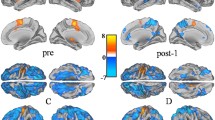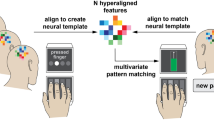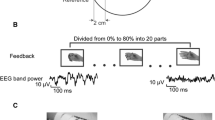Abstract
Research using functional magnetic resonance imaging has for numerous years now reported the existence of a negative blood oxygenation level dependent (BOLD) response. Based on accumulating evidence, this negative BOLD signal appears to represent an active inhibition of cortical areas in which it is found during task activity. This particularly important with respect to motor function given that it is fairly well-established that, in younger adults, the ipsilateral sensorimotor cortex exhibits negative BOLD during unimanual movements in fMRI. This interhemispheric suppression of cortical activity may have useful implications for our understanding of both basic motor function and rehabilitation of injury or disease. However, to date, we are aware of no study that has tested the reliability of evoked negative BOLD in ipsilateral sensorimotor cortex in individuals across sessions. The current study employs a unimanual finger opposition task previously shown to evoke negative BOLD in ipsilateral sensorimotor cortex across three sessions. Reliability metrics across sessions indicates that both the magnitude and location of ipsilateral sensorimotor negative BOLD response is relatively stable over each of the three sessions. Moreover, the volume of negative BOLD in ipsilateral cortex was highly correlated with volume of positive BOLD activity in the contralateral primary motor cortex. These findings show that the negative BOLD signal can be reliably evoked in unimanual task paradigms, and that the signal dynamic could represent an active suppression of the ipsilateral sensorimotor cortex originating from the contralateral motor areas.





Similar content being viewed by others
References
Addamo, P. K., Farrow, M., Hoy, K. E., Bradshaw, J. L., & Georgiou-Karistianis, N. (2007). The effects of age and attention on motor overflow production—a review. Brain Research Reviews, 54(1), 189–204.
Allison, J. D., Meador, K. J., Loring, D. W., Figueroa, R. E., & Wright, J. C. (2000). Functional MRI cerebral activation and deactivation during finger movement. Neurology, 54, 135–142.
Altman, D. G., & Bland, J. M. (1983). Measurement in medicine: the analysis of method comparison studies. The Statistician, 32, 307–317.
Berlucchi, G. (1990). Commisurotomy studies in animals. In F. Boller & J. Grafman (Eds.), Handbook of neurophysiology. Vol. 4 (pp. 9–47). Amsterdam: Elsevier.
Birn, R. M., Diamond, J. B., Smith, M. A., & Bandettini, P. A. (2006). Separating respiratory-variation-related fluctuations from neuronal-activity-related fluctuations in fMRI. NeuroImage, 31(4), 1536–1548.
Boorman, L., et al. (2010). Negative blood oxygen level dependence in the rat: a model for investigating the role of suppression in neurovascular coupling. Journal of Neuroscience, 30(12), 4285–4294.
Bright, M. G., Bianciardi, M., de Zwart, J. A., Murphy, K., Duyn, J. H., (2014) Early anti-correlated BOLD signal changes of physiologic origin. Neuroimage, 15(87), 287–96.
Davidson, T., & Tremblay, F. (2013). Age and hemispheric differences in transcallosal inhibition between motor cortices: an ispsilateral silent period study. BMC Neuroscience, 14, 62.
Devor, A., et al. (2007). Suppressed neuronal activity and concurrent arteriolar vasoconstriction may explain negative blood oxygenation level-dependent signal. Journal of Neuroscience, 27(16), 4452–4459.
Diedrichsen, J., Wiestler, T., & Krakauer, J. W. (2013). Two distinct ipsilateral cortical representations for individuated finger movements. Cerebral Cortex, 23(6), 1362–1377.
Diekhoff, S., Uludağ, K., Sparing, R., Tittgemeyer, M., Cavuşoğlu, M., von Cramon, D, Y., et al. (2011) Functional localization in the human brain: Gradient-Echo, Spin-Echo, and arterial spin-labeling fMRI compared with neuronavigated TMS. Hum Brain Mapp, 32(3), 341–57.
Ferbert, A., Priori, A., Rothwell, J. C., Day, B. L., Colebatch, J. G., & Marsden, C. D. (1992). Interhemispheric inhibition of the human motor cortex. Journal of Physiology, 453(1), 525–546.
Fesl, G., Braun, B., Rau, S., Wiesmann, M., Ruge, M., Bruhns, P., et al. (2008). Is the center of mass (COM) a reliable parameter for the localization of brain function in fMRI? Eur Radiol, 18(5), 1031–7.
Genovese, C. R., Lazar, N. A., & Nichols, T. (2002). Thresholding of statistical maps in functional neuroimaging using the false discovery rate. NeuroImage, 15, 870–878.
Goense, J., Merkle, H., & Logothetis, N. K. (2012). High-resolution fMRI reveals laminar differences in neurovascular coupling between positive and negative BOLD responses. Neuron, 76(3), 629–639.
Hayes, D. J., & Huxtable, A. G. (2012). Interpreting deactivations in neuroimaging. Frontiers in Psychology, 3, 27.
Hlushchuk, Y., & Hari, R. (2006). Transient suppression of ipsilateral primary somatosensory cortex during tactile finger stimulation. Journal of Neuroscience, 26, 5819–5824.
Hoy, K. E., Fitzgerald, P. B., Bradshaw, J. L., Armatas, C. A., & Georgiou-Karistianis, N. (2004). Investigating the cortical origins of motor overflow. Brain Research Reviews, 46(3), 315–327.
Jaccard, P. (1901). Étude comparative de la distribution florale dans une portion des Alpes et des Jura. Bulletin de la Société Vaudoise des Sciences Naturelles, 37, 547–579.
Jancke, L., Shah, N. J., & Peters, M. (2000). Cortical activations in primary and secondary motor areas for complex bimanual movements in professional pianists. Brain Research. Cognitive Brain Research, 10, 177–183.
Kastrup, A., Baudewig, J., Schnaudigel, S., Huonker, R., Becker, L., Sohns, J. M., et al. (2008). Behavioral correlates of negative BOLD signal changes in the primary somatosensory cortex. NeuroImage, 41, 1364–1371.
Klingner, C. M., Hasler, C., Brodoehl, S., & Witte, O. W. (2010). Dependence of the negative BOLD response on somatosensory stimulus intensity. NeuroImage, 53, 189–195.
Klingner, C. M., Huonker, R., Flemming, S., Hasler, C., Brodoehl, S., Preul, C., et al. (2011). Functional deactivations: multiple ipsilateral brain areas engaged in the processing of somatosensory information. Human Brain Mapping, 32, 127–140.
Kobayashi, M., Hutchinson, S., Schlaug, G., Pascual-Leone, A. (2003). Ipsilateral motor cortex activation on functional magnetic resonance imaging during unilateral hand movements is related to interhemispheric interactions. Neuroimage, 20(4), 2259–2270.
Krampe, R. T., Engbert, R., & Kliegl, R. (2002). The effects of expertise and age on rhythm production: adaptations to timing and sequencing constraints. Brain and Cognition, 48, 179–194.
Lenzi, D., Conte, A., Mainero, C., Frasca, V., Fubelli, F., Totaro, P., et al. (2007). Effect of corpus callosum damage on ipsilateral motor activation in patients with multiple sclerosis: a functional and anatomical study. Human Brain Mapping, 28, 636–644.
Maitra, R. (2009). A re-defined and generalized percent-overlap-of-activation measure for studies of fMRI reproducibility and its use in identifying outlier activation maps. NeuroImage, 50(1), 124–135. doi:10.1016/j.neuroimage.2009.11.070.
Malcolm, M. P., Triggs, W. J., Light, K. E., Shechtman, O., Khandekar, G., & Gonzalez Rothi, L. J. (2006). Reliability of motor cortex transcranial magnetic stimulation in four muscle representations. Clinical Neurophysiology, 117, 1037–1046.
Manson, S. C., Palace, J., Frank, J. A., & Matthews, P. M. (2006). Loss of interhemispheric inhibition in patients with multiple sclerosis is related to corpus callosum atrophy. Experimental Brain Research, 174, 728–733.
Manson, S. C., Wegner, C., Filippi, M., Barkhof, F., Beckmann, C., Ciccarelli, O., et al. (2008). Impairment of movement-associated brain deactivation in multiple sclerosis: further evidence for a functional pathology of interhemispheric neuronal inhibition. Experimental Brain Research, 187, 25–31.
Mayston, M. J., Harrison, L. M., Quinton, R., Stephens, J. A., Krams, M., Bouloux, P. M. (1997). Mirror movements in X-linked Kallmann’s syndrome. I. A neurophysiological study. Brain, 120(Pt 7), 1199–1216.
Mayston, M. J., Harrison, L. M., & Stephens, J. A. (1999). A neurophysiological study of mirror movements in adults and children. Annals of Neurology, 45(5), 583–594.
McGraw, K. O., & Wong, S. P. (1996). Forming inferences about some intraclass correlation coefficients. Psychological Methods, 1(1), 30.
McGregor, K., Craggs, J., Benjamin, M., Crosson, B., & White, K. (2009). Age-related changes in motor control during unimanual movements. Brain Imaging and Behavior, 3, 317–331.
McGregor, K. M., Zlatar, Z., Kleim, E., Sudhyadhom, A., Bauer, A., Phan, S., et al. (2011). Physical activity and neural correlates of aging: a combined TMS/fMRI study. Behavioural Brain Research, 222, 158–168.
McGregor, K., Heilman, K., Nocera, J., Patten, C., Manini, T., Crosson, B., et al. (2012a). Aging, aerobic activity and interhemispheric communication. Brain Sciences, 2, 634–648.
McGregor, K. M., Carpenter, H., Kleim, E., Sudhyadhom, A., White, K. D., Butler, A. J., et al. (2012b). Motor map reliability and aging: a TMS/fMRI study. Experimental Brain Research, 219, 97–106.
McGregor, K. M., Nocera, J. R., Sudhyadhom, A., Patten, C., Manini, T. M., Kleim, J. A., et al. (2013). Effects of aerobic fitness on aging-related changes of interhemispheric inhibition and motor performance. Frontiers in Aging Neuroscience, 5, 66.
Meyer, B. U., Roricht, S., & Woiciechowsky, C. (1998). Topography of fibers in the human corpus callosum mediating interhemispheric inhibition between the motor cortices. Annals of Neurology, 43, 360–369.
Newton, J. M., Sunderland, A., & Gowland, P. A. (2005). fMRI signal decreases in ipsilateral primary motor cortex during unilateral hand movements are related to duration and side of movement. NeuroImage, 24, 1080–1087.
Northoff, G., Walter, M., Schulte, R. F., Beck, J., Dydak, U., Henning, A., … & Boesiger, P. (2007). GABA concentrations in the human anterior cingulate cortex predict negative BOLD responses in fMRI. Nature Neuroscience, 10(12), 1515–1517.
Oldfield, R. C. (1971). The assessment and analysis of handedness: the Edinburgh Inventory. Neuropsychologia, 9, 97–113.
Ottaviani, D., Tiple, D., Suppa, A., Colosimo, C., Fabbrini, G., Cincotta, M., et al. (2008). Mirror movements in patients with Parkinson’s disease. Movement Disorders, 23(2), 253–258.
Portney, L. G., & Watkins, M. P. (1993). Chapter 26: Statistical measures of reliability. Foundation of clinical research: Applications to practice. Norwich: Appleton and Lange.
Real, R. (1999). Tables of significant values of Jaccard’s index of similarity. Miscellaneous Zoologica, 22(1), 29–40.
Reddy, H., Lassonde, M., Bemasconi, N., Bemasconi, A., Matthews, P. M., Andermann, F., et al. (2000). An fMRI study of the lateralization of motor cortex activation in acallosal patients. Neuroreport, 11(11), 2409–2413.
Riecker, A., Groschel, K., Ackermann, H., Steinbrink, C., Witte, O., & Kastrup, A. (2006). Functional significance of age-related differences in motor activation patterns. NeuroImage, 32, 1345–1354.
Saad, Z. S., Glen, D. R., Chen, G., Beauchamp, M. S., Desai, R., & Cox, R. W. (2009). A new method for improving functional-to-structural MRI alignment using local Pearson correlation. NeuroImage, 44, 839–848.
Salthouse, T. A. (1996). The processing-speed theory of adult age differences in cognition. Psychol Rev, 103(3), 403–28.
Sattler, V., Dickler, M., Michaud, M., Meunier, S., Simonetta-Moreau, M. (2013). Does abnormal interhemispheric inhibition play a role in mirror dystonia? Movement Disorders.
Sherrington, C. S. (1932). Nobel Prize Lecture. http://www.nobelprize.org/nobel_prizes/medicine/laureates/1932/press.html. Accessed 28 April 2014.
Shmuel, A., Yacoub, E., Pfeuffer, J., Van de Moortele, P. F., Adriany, G., Hu, X., et al. (2002). Sustained negative BOLD, blood flow and oxygen consumption response and its coupling to the positive response in the human brain. Neuron, 36(6), 1195–1210.
Shmuel, A., Augath, M., Oeltermann, A., & Logothetis, N. K. (2006). Negative functional MRI response correlates with decreases in neuronal activity in monkey visual area V1. Nature Neuroscience, 9(4), 569–577.
Smith, A. T., et al. (2004). Negative BOLD in the visual cortex: evidence against blood stealing. Human Brain Mapping, 21(4), 213–220.
Stagg, C. J., Bestmann, S., Constantinescu, A. O., Moreno, L. M., Allman, C., Mekle, R., et al. (2011) Relationship between physiological measures of excitability and levels of glutamate and GABA in the human motor cortex. Journal of Physiology, 589(Pt 23), 5845–55.
Stefanovic, B., Warnking, J. M., & Pike, G. B. (2004). Hemodynamic and metabolic responses to neuronal inhibition. NeuroImage, 22, 771–778.
Talelli, P., Waddingham, W., Ewas, A., Rothwell, J. C., & Ward, N. S. (2008). The effect of age on task-related modulation of interhemispheric balance. Experimental Brain Research, 186, 59–66.
Verstynen, T., Spencer, R., Stinear, C. M., Konkle, T., Diedrichsen, J., Byblow, W. D., et al. (2007). Ipsilateral corticospinal projections do not predict congenital mirror movements: a case report. Neuropsychologia, 45, 844–852.
Yousry, T. A., Schmid, U. D., Alkadhi, H., Schmidt, D., Peraud, A., Buettner, A., et al. (1997). Localization of the motor hand area to a knob on the precentral gyrus. A new landmark. Brain, 120(Pt 1), 141–57.
Yuan, H., Perdoni, C., Yang, L., & He, B. (2011). Differential electrophysiological coupling for positive and negative BOLD responses during unilateral hand movements. The Journal of Neuroscience, 31, 9585–9593.
Zeharia, N., Hertz, U., Flash, T., & Amedi, A. (2012). Negative blood oxygenation level dependent homunculus and somatotopic information in primary motor cortex and supplementary motor area. Proceedings of the National Academy of Sciences of the United States of America, 109, 18565–18570.
Acknowledgments
The contents do not represent the views of the Department of Veterans Affairs or the United States Government. This work was supported by a Department of Veteran Affairs (VA) Rehabilitation R&D Center of Excellence #F2182C, Career Development Award Level-2 (KMM) and Senior Research Career Scientist (BC: #B6364L) awards.
Conflict of interest
Keith M. McGregor, Atchar Sudhyadhom, Joe Nocera, Ari Seff, Bruce Crosson, and Andrew J. Butler report no conflicts of interest.
Informed consent
All procedures followed were in accordance with the ethical standards of the responsible committee on human experimentation (institutional and national) and with the Helsinki Declaration of 1975, and the applicable revisions at the time of the investigation. Informed consent was obtained from all patients for being included in the study.
Author information
Authors and Affiliations
Corresponding author
Electronic supplementary material
Below is the link to the electronic supplementary material.
Supplementary Fig. 6
(JPG 12.1 kb)
Rights and permissions
About this article
Cite this article
McGregor, K.M., Sudhyadhom, A., Nocera, J. et al. Reliability of negative BOLD in ipsilateral sensorimotor areas during unimanual task activity. Brain Imaging and Behavior 9, 245–254 (2015). https://doi.org/10.1007/s11682-014-9302-3
Published:
Issue Date:
DOI: https://doi.org/10.1007/s11682-014-9302-3




